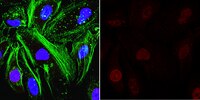Nuclear protein import in permeabilized mammalian cells requires soluble cytoplasmic factors.
Adam, SA; Marr, RS; Gerace, L
The Journal of cell biology
111
807-16
1990
Show Abstract
We have developed an in vitro system involving digitonin-permeabilized vertebrate cells to study biochemical events in the transport of macromolecules across the nuclear envelope. While treatment of cultured cells with digitonin permeabilizes the plasma membranes to macromolecules, the nuclear envelopes remain structurally intact and nuclei retain the ability to transport and accumulate proteins containing the SV40 large T antigen nuclear location sequence. Transport requires addition of exogenous cytosol to permeabilized cells, indicating the soluble cytoplasmic factor(s) required for nuclear import are released during digitonin treatment. In this reconstituted import system, a protein containing a nuclear location signal is rapidly accumulated in nuclei, where it reaches a 30-fold concentration compared to the surrounding medium within 30 min. Nuclear import is specific for a functional nuclear location sequence, requires ATP and cytosol, and is temperature dependent. Furthermore, accumulation of the transport substrate within nuclei is completely inhibited by wheat germ agglutinin, which binds to nuclear pore complexes and inhibits transport in vivo. Together, these results indicate that the permeabilized cell system reproduces authentic nuclear protein import. In a preliminary biochemical dissection of the system, we observe that the sulfhydryl alkylating reagent N-ethylmaleimide inactivates both cytosolic factor(s) and also component(s) in the insoluble permeabilized cell fraction required for nuclear protein import. Because this permeabilized cell model is simple, efficient, and works effectively with cells and cytosol fractions prepared from a variety of different vertebrate sources, it will prove powerful for investigating the biochemical pathway of nuclear transport. | 2391365
 |
Monoclonal antibodies identify a group of nuclear pore complex glycoproteins.
Snow, CM; Senior, A; Gerace, L
The Journal of cell biology
104
1143-56
1987
Show Abstract
Using monoclonal antibodies we identified a group of eight polypeptides of rat liver nuclear envelopes that have common epitopes. Most or all of these proteins are structurally distinct, as shown by tryptic peptide mapping and analysis with polyclonal antibodies. While these polypeptides are relatively tightly bound to nuclear membranes, only one is an integral membrane protein. The eight antigens cofractionate with the nuclear pore complex under various conditions of ionic strength and detergent. It can be seen by immunofluorescence microscopy that the monoclonal antibodies reacting with these antigens stain the nuclear surface of interphase cells in a finely punctate pattern. When the nuclear envelope is disassembled and subsequently reformed during mitosis, the proteins are reversibly dispersed throughout the cytoplasm in the form of minute foci. By EM immunogold localization on isolated nuclear envelopes, the monoclonal antibodies label exclusively the nuclear pore complex, at both its nucleoplasmic and cytoplasmic margins. Considered together, our biochemical and localization data indicate that the eight nuclear envelope polypeptides are pore complex components. As shown in the accompanying paper (Holt, G. D., C. M. Snow, A. Senior, R. S. Haltiwanger, L. Gerace, and G. W. Hart, J. Cell Biol., 104:1157-1164) these eight polypeptides contain a novel form of glycosylation, O-linked N-acetylglucosamine. The relative abundance and disposition of these O-linked glycoproteins in the pore complex are consistent with their having a role in nucleocytoplasmic transport. | 2437126
 |
Nuclear pore complex glycoproteins contain cytoplasmically disposed O-linked N-acetylglucosamine.
Holt, GD; Snow, CM; Senior, A; Haltiwanger, RS; Gerace, L; Hart, GW
The Journal of cell biology
104
1157-64
1987
Show Abstract
A novel form of protein-saccharide linkage consisting of single N-acetylglucosamine (GlcNAc) residues attached in O-linkages directly to the polypeptide backbone has been described (Holt, G. D., and G. W. Hart, 1986, J. Biol. Chem., 261:8049-8057). This modification was found on proteins distributed throughout the cell, although proteins bearing O-linked GlcNAc moieties were particularly abundant in the cytosolic and nuclear envelope fractions of rat liver. In the accompanying article (Snow, C. M., A. Senior, and L. Gerace, 1987, J. Cell. Biol., 104: 1143-1156), the authors describe monoclonal antibodies directed against eight proteins localized to the nuclear pore complex. These proteins occur on the cytoplasmic and nucleoplasmic (but not lumenal) sides of nuclear membranes. In this report, we demonstrate that all members of this group of pore complex proteins bear multiple O-linked GlcNAc residues. Further, we show that the O-linked GlcNAc moieties are linked via serine (and possibly threonine) side chains to these proteins. Perturbing the O-linked GlcNAc residues either by covalently attaching galactose to them or by releasing them with beta-N-acetylglucosaminidase strongly diminishes the immunoreactivity of the proteins with all of the monoclonal antibodies. However, the O-linked GlcNAc moieties are only part of the epitopes recognized, since O-GlcNAc-containing limit pronase fragments of nuclear pore complex proteins cannot be immunoprecipitated by these antibodies. These findings, taken together with those in the accompanying article, are a direct demonstration that proteins of the cytoplasm and nucleoplasm bear O-linked GlcNAc residues. | 3571327
 |









